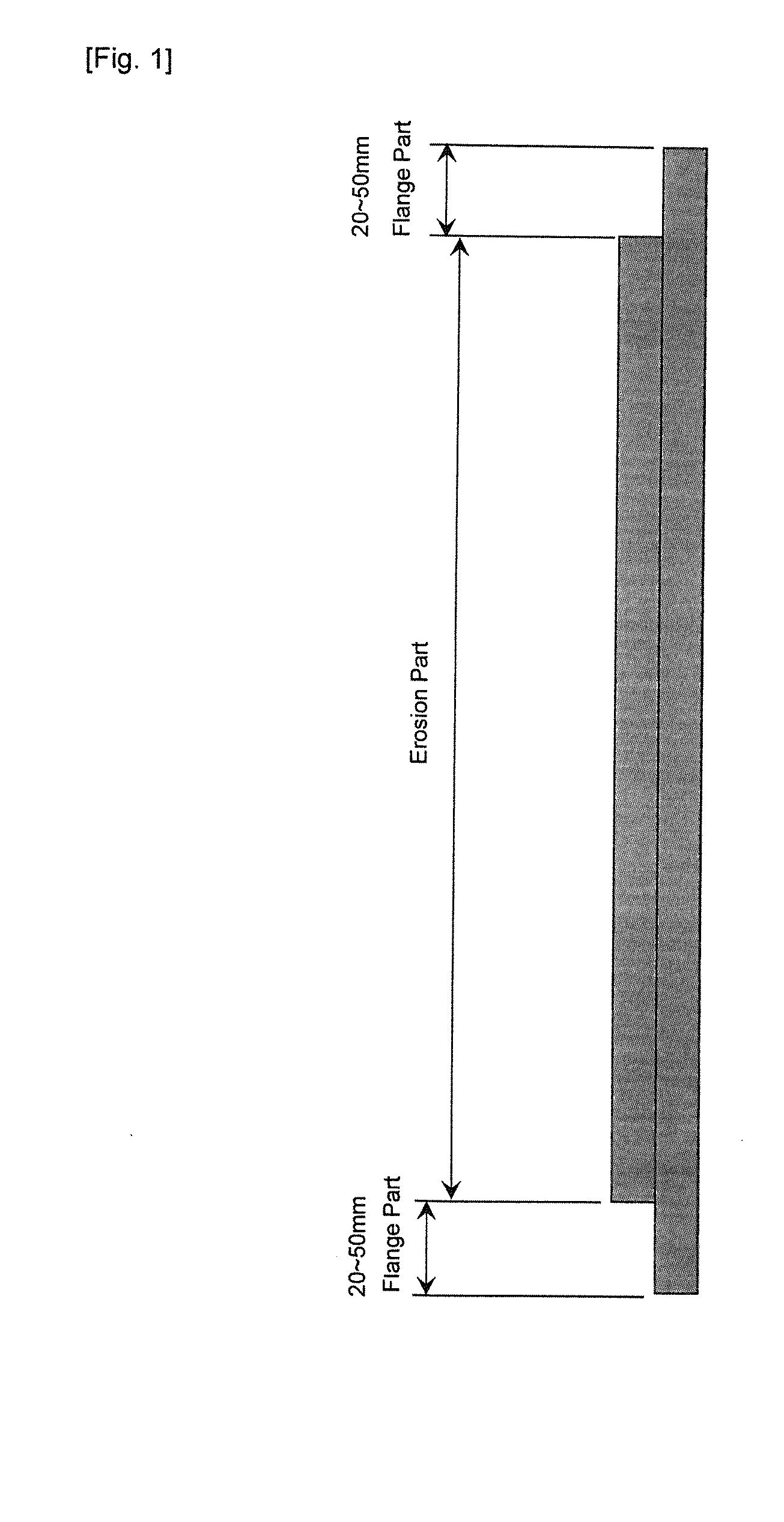High-Purity Copper Sputtering Target
a high-purity, copper technology, applied in the direction of electrolysis components, vacuum evaporation coatings, coatings, etc., can solve the problems of affecting the uniformity of film thickness, affecting the utilization efficiency of target thereby deteriorating, and high input power of sputtering, so as to improve the strength of flange parts, improve the uniformity, and improve the effect of yield stress
- Summary
- Abstract
- Description
- Claims
- Application Information
AI Technical Summary
Benefits of technology
Problems solved by technology
Method used
Image
Examples
example 1
[0042]High-purity copper (Cu) of purity 6N was melted in a high vacuum atmosphere using a carbon crucible. Molten metal of the copper was casted into a carbon mold in a high vacuum atmosphere to obtain an ingot. Subsequently, the produced ingot was subject to warm forging at 400° C. Subsequently, after a required amount was cut, the cut part was subject to rolling (cold working ratio of 82%) to attain a size of 530 (diameter)×30 (thickness), subject to heat treatment at 300° C. for 1 hour, and a range of 20 mm from the outer periphery was thereafter subject to cold forging (working ratio of 50%).
[0043]Subsequently, the obtained product was machined and processed into a target having a target part diameter of 430 mm, and a total thickness of 25 mm. Consequently, the target part had a recrystallized structure of roughly 35 μm, and the flange part became a worked structure based on cold working. In the foregoing case, since the flange part is of a worked structure, the crystal grain si...
example 2
[0048]High-purity copper (Cu) of purity 6N was melted in a high vacuum atmosphere using a carbon crucible. Molten metal of the copper was casted into a carbon mold in a high vacuum atmosphere to obtain an ingot.
[0049]Subsequently, the produced ingot was subject to warm forging at 400° C. Subsequently, after a required amount was cut, the cut part was subject to rolling (cold working ratio of 80%) to attain a size of 530 (diameter)×30 (thickness), subject to heat treatment at 325° C. for 1 hour, and a range of 30 mm from the outer periphery was thereafter subject to cold forging (working ratio of 40%). Subsequently, the obtained product was machined and processed into a target having a target part diameter of 430 mm, and a total thickness of 25 mm.
[0050]With regard to the high-purity copper sputtering target produced as described above, the hardness (Vickers hardness Hv) of the flange part, the (111) orientation ratio (%) of the erosion part, and the crystal grain size (μm) were exam...
example 3
[0054]High-purity copper (Cu) of purity 6N was melted in a high vacuum atmosphere using a carbon crucible. Molten metal of the copper was casted into a carbon mold in a high vacuum atmosphere to obtain an ingot. Subsequently, the produced ingot was subject to warm forging at 400° C. Subsequently, after a required amount was cut, the cut part was subject to rolling (cold working ratio of 80%) to attain a size of 530 (diameter)×30 (thickness), subject to heat treatment at 325° C. for 1 hour, and a range of 40 mm from the outer periphery was thereafter subject to cold forging (working ratio of 40%). Subsequently, the obtained product was machined and processed into a target having a target part diameter of 430 mm, and a total thickness of 25 mm.
[0055]With regard to the high-purity copper sputtering target produced as described above, the hardness (Vickers hardness Hv) of the flange part, the (111) orientation ratio (%) of the erosion part, and the crystal grain size (μm) were examined....
PUM
| Property | Measurement | Unit |
|---|---|---|
| crystal grain size | aaaaa | aaaaa |
| diameter | aaaaa | aaaaa |
| yield strength | aaaaa | aaaaa |
Abstract
Description
Claims
Application Information
 Login to View More
Login to View More - R&D
- Intellectual Property
- Life Sciences
- Materials
- Tech Scout
- Unparalleled Data Quality
- Higher Quality Content
- 60% Fewer Hallucinations
Browse by: Latest US Patents, China's latest patents, Technical Efficacy Thesaurus, Application Domain, Technology Topic, Popular Technical Reports.
© 2025 PatSnap. All rights reserved.Legal|Privacy policy|Modern Slavery Act Transparency Statement|Sitemap|About US| Contact US: help@patsnap.com


